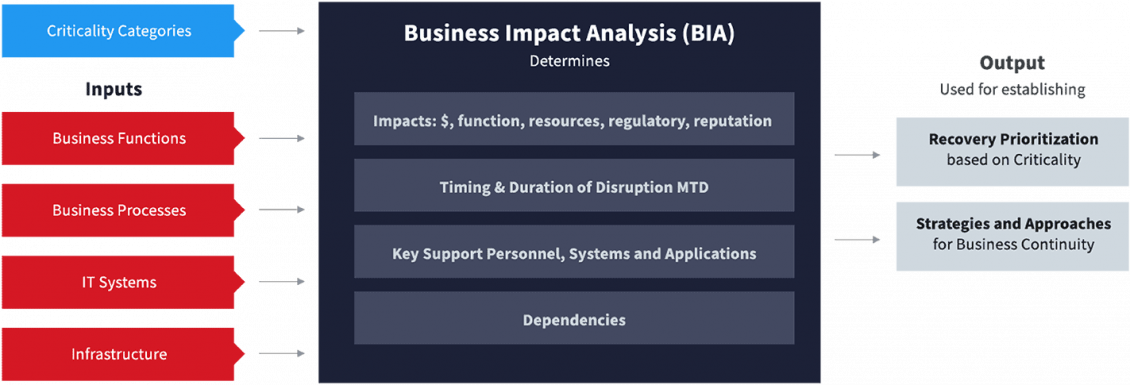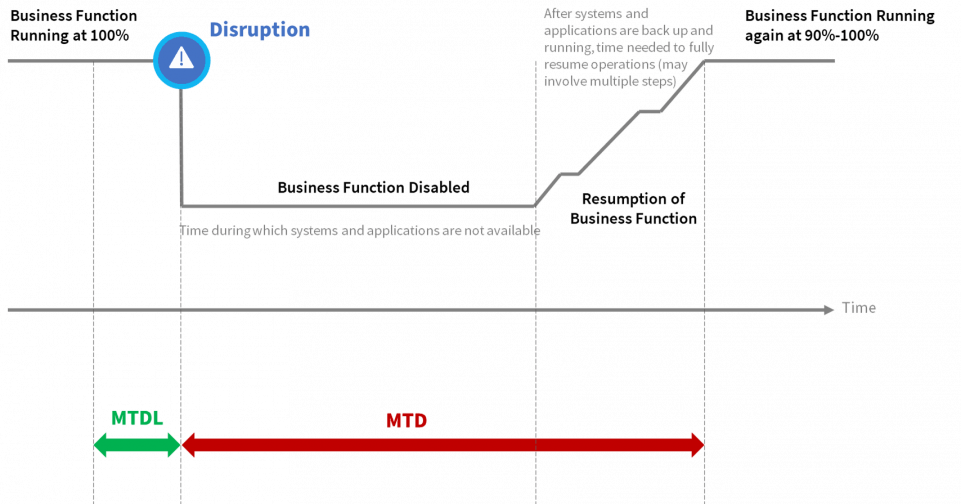BIA | Business Impact Analysis
A-to-Zerto Glossary of Terms
What Is Business Impact Analysis?
BIA looks at the critical, time-sensitive operations of your organization to determine what will happen in the event of any interruption, disruption, or disaster, including natural disasters. With an emphasis on business continuity requirements and resource dependencies, BIA shows how downtime will impact the organization and therefore justifies certain business requirements.
BIA is part of the business continuity planning and helps to identify the critical business processes, and their related resources, systems, and services.
As shown in figure 1 below, all business functions, processes, IT systems and services, infrastructure elements become an input to the BIA process.

Figure 1: BIA process (inputs, processing, outputs)
Criticality categories are used to determine the mission-critical functions or processes that will most likely become the focus from a business continuity standpoint. For a given process, criticality may change over time as the impact of that process worsens the longer it remains unavailable.
As its name says it, the BIA also estimates the impact of the loss of a critical business process in terms of financial cost, reputational damage, regulatory compliance, and much more.
Business continuity management team members then use the information to set up business recovery strategies. With an emphasis on business continuity requirements and resource dependencies, a BIA shows how downtime will impact the organization and therefore justifies certain business requirements.
Steps Involved in the BIA Process
Definition of Criticality Categories
Inputs to a BIA report become metrics that help business leaders identify the critical path for recovery—i.e., what systems and processes need urgent attention during and after a disruption. To designate these metrics, you can assign a criticality rating to each business function based on ascending or descending levels of priority.
For instance, you can develop a criticality rating scale similar to the one below:
- Category 1: Critical functions
- Category 2: Essential functions
- Category 3: Necessary functions
- Category 4: Desirable functions
A function's criticality category helps you decide the appropriate amount of time and resources to spend on risk mitigation and recovery. Functions with the greatest impact on your business operations belong in category 1. Their recovery time is described in minutes and hours, not days, and as such they are the topmost priority for recovery.
BIA Outputs in Business Continuity and DR Processes
The BIA is a core requirement for proactive business continuity planning (BCP), and its outputs form the basis for BCP and DR planning. The outputs of a BIA include:
- Mapping impact types
- Establishing maximum tolerable downtime (MTD), which leads to recovery time objective (RTO)
- Identifying tolerance for different impacts, including maximum tolerable data loss (MTDL), which leads to recovery point objective (RPO)
- Strategizing incident response and achieving operational resumption within the stipulated MTDs
- Recommending impact mitigation plans for business processes
Business continuity planning cannot be done unless the BIA is first completed. After this, organizations can then create one or more DR plans outlining methods, processes, and resources needed to restore these critical systems in the event of a disaster or outage.
MTD and MTDL: Differences and Considerations
RTO and RPO: Differences and Considerations
Where Does BIA Stand Overall in the Risk Management Process?
BIA is a key element of the business continuity planning along with risk assessment. They both inform the establishment of the business continuity plan and the disaster recovery plan that are part of Risk Management for operational risks. Operational risks are mainly related to failed processes or events that cause disruption over business operations. Figure 2 below illustrates what the risk management process looks like for operational risks.
Risk management overall covers other areas such as strategic, financial and compliance and governance risks that are mainly managed through business or corporate strategy.
Figure 2: Risk Management Process for Operational Risks
The quality of the BIA will set the bar for an organization Risk Management process outcome. Getting it done right doesn’t ensure the quality of the whole process, but not putting the right effort into it is a guarantee to failure.
What is Risk Management?
Risk Management Process for Operational Risks - Overview
What is the Difference Between BIA and Risk Assessment?
You can undertake a BIA without risk assessment, but every risk assessment involves some sort of business impact analysis.
A business impact analysis explains the effects of and the severity of the loss of key business functions and/or processes, disregarding of what is responsible for that loss. It doesn’t matter what caused the loss of the business function or process. What counts is to understand the impact of the loss to determine the recovery plan and timeframes to resume operations.
Risk assessment analyze potential threats and vulnerabilities that make up a risk, then assess the likelihood of this risk happening. It also spells out how the business would be affected, what resources and functions would be impacted. This leads to the prioritization — i.e., tiering—of these risks.
It also helps business leaders determine how a specific threat will affect business operations. Essentially, risk assessment identifies potential risks, assesses their severity, and determines the best course of action to mitigate or eliminate them.
When combined, BIA and RA enable a business to focus on the most critical risks or threats based on their likelihood and impact.
Risk assessment, which is a related step of business continuity planning, identifies specific potential disasters and setbacks such as cyber-attacks, network failure, natural disaster, supplier failure, utility outage, and so forth. The risk assessment focuses on mitigating these areas of vulnerability.
BIA, in turn, attempts to predict how any of the identified risks, exposed through the risk assessment stage, would affect the business if they were to occur. This will determine the type of recovery for each of these risks is required to mitigate the impact on the business and ensure business continuity. For IT disaster recovery, the conclusions of the BIA will drive the RTOs and RPOs requirements associated with all types of applications and processes supporting the business.
Risk Assessment: 3 Key Starting Points for Effective Business Impact Analysis
What Comes First: Business Impact Analysis or Risk Assessment?
Undertaking a risk assessment enables businesses to:
- Create a comprehensive list of potential risks that could affect a business
- Categorize each risk by the severity and scope of its impact
- Determine the likelihood of each risk occurring
- Identify the best mitigation/remediation options
- Generate a comprehensive report for organizational leaders and stakeholders.
It's important to note that BIAs are a type of risk assessment exercise and can serve as functional extensions of its goals and objectives. However, there is some debate as to whether a risk assessment should follow or precede BIA. There are advantages to both.
On one hand, beginning with the BIA is a faster way to start the business continuity process. It quickly identifies the critical business functions and processes and assesses the impact of possible losses. Indeed, it's been shown that the output of a BIA drives business continuity and disaster recovery plans. From a business continuity standpoint, it doesn’t matter what caused the disruption—the key is recovering as fast as possible to keep the business running.
Conversely, first conducting risk assessment enables organizations to identify risks with the highest likelihood of occurrence, as well as the business functions the risks will impact. The BIA team can then focus on the highest priority risks, zero in on the worst-case scenarios, and gather information needed to develop recovery objectives, plans, solutions, and strategies.
When conducting the risk assessment first, the risk analysis portion will partially cover what the BIA would provide, such as estimating financial, legal, and other impacts from potential risks.
Risk Assessment and Risk Identification
Risk Analysis
BIA and SLA Metrics
Within the context of business continuity, a service level agreement, or SLA, represents a promise about how long a business process or function will remain unavailable in the event of a disruption and assume the commitment of every party involved.
Through the BIA, an organization will estimate the downtime it can tolerate for a given process or function. This will be reflected in the SLA for that process.
One output of the BIA is the estimation of the maximum tolerable time (MTD) and maximum tolerable data loss (MTDL) that can be sustained over a given business process. These two metrics will be used by the disaster recovery (DR) teams to determine the RPOs and RTOs required to meet the SLA.

Risk Assessment, BIA, SLA, RTO and RPO: What's the Link? MTD and MTDL
A Solution to Meet Your Most Stringent SLAs
Zerto understands that unplanned disruptions do not just affect IT operations—they have a domino effect on your entire organization. As a BIA will show, your organization’s reliance on technology to maintain operations and remain visible to the world steadily increases. Zerto enables an always-on experience that transforms business as usual, helping you realize your innovation goals.
The Zerto solution ensures that your IT systems remain resilient through the identified potential disruptions and can deliver the RPOs and RTOs that meet the most stringent SLAs established through your BIA.
By providing the best recovery point objective (RPO) and recovery time objective (RTO) at scale in the market, Zerto simplicity and resilience supports true business continuity.
Zerto Solution Overview
Other Resources
LATEST FROM ZERTO SEE ALL
Resource Center
Discover and access content from Zerto and 3rd parties (IDC, Gartner, ESG, etc.) related to Business Continuity.
The Key Components of a Business Continuity Plan (BCP)
Learn about the essential elements that should be part of any serious BCP.
Essential Guide: Disaster Recovery
Get everything you need to know about disaster recovery in one guide.
What is Zerto?
Learn about Zerto and how it can help you solve your data protection and recovery challenges.